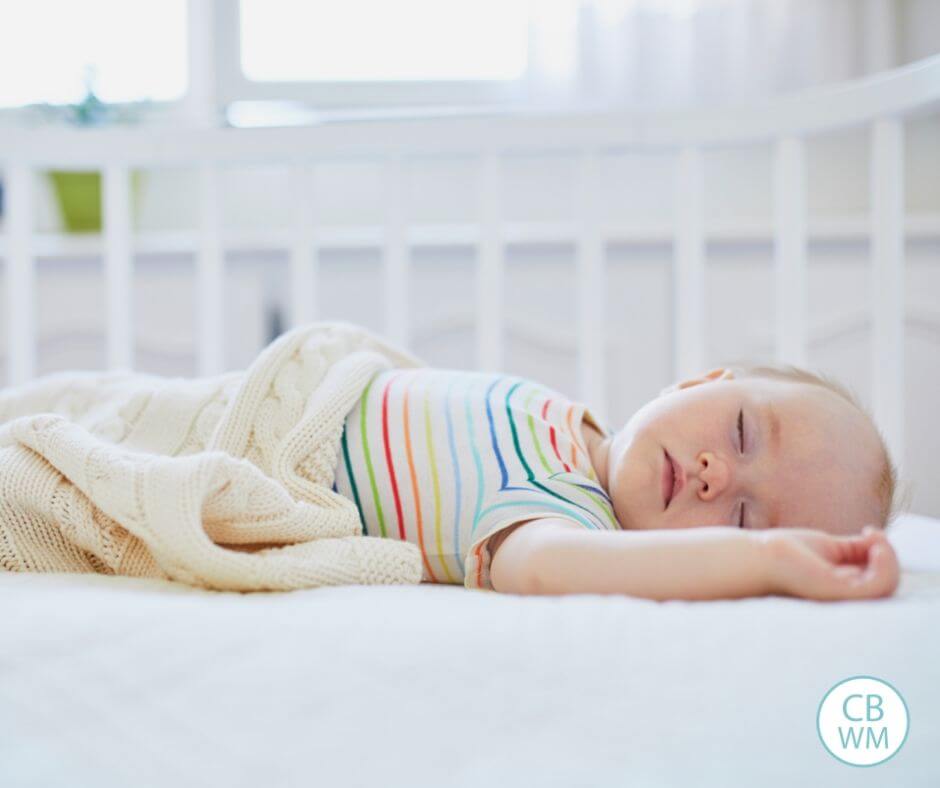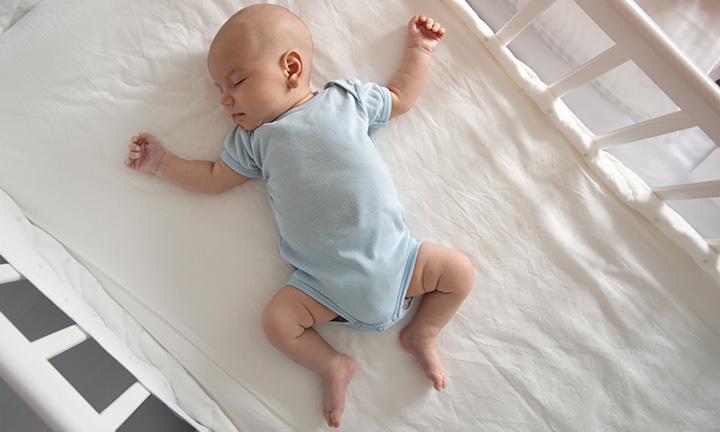How to Get Baby to Sleep in Crib?
To get a baby to sleep in their crib, it is important to have a calming and comfortable sleeping environment. Start by creating a bedtime routine that involves activities such as reading stories or singing songs. Make sure the nursery is dark and quiet, with white noise or soothing music playing if necessary.
Use blankets and stuffed animals for comfort but be sure there are no loose items in the crib that could become choking hazards. It’s best to put your baby down when they are already drowsy so you can avoid having them fall asleep while being held or rocked. Finally, make sure the temperature of the room is at an optimal level – not too hot or cold – so your little one can drift off without any discomfort.
- Step 1: Establish a Bedtime Routine: Set up a calming and consistent bedtime routine for your baby. This could include giving them a bath, reading a book, singing songs and cuddling. Doing the same things in the same order every night will help your baby to understand when it is time to sleep.
- Step 2: Put Your Baby in Crib Awake: Once you have completed your bedtime routine, put your baby into their crib while they are still awake. Make sure that their environment is comfortable with just enough light so that they can see around them but not too much as this could be stimulating for them.
- Step 3: Soothe Gently if Needed: If your baby is fussy or crying let them know that you are there by speaking softly and calmly reassuring them of your presence without picking them up again. You can also try rubbing their back gently until they calm down.
- Step 4: Be Patient and Consistent : If after soothing techniques haven’t worked then it’s important to remain patient and consistent until the situation improves over time. Remember that all babies learn at different rates so don’t get discouraged if getting yours to sleep in the crib takes some extra effort on y our part!

Credit: www.babywisemom.com
How Do I Get My Baby to Sleep in His Crib Without Crying It Out?
One of the most difficult things for new parents is helping their baby to sleep in his or her crib without crying it out. This can be a long and challenging process, but with patience and consistency you can get your baby to feel comfortable and safe when sleeping in their own bed. One important step is making sure that the crib is set up correctly; ensure that there are no gaps between the mattress and frame, so your baby won’t get stuck if they move around during sleep.
Also make sure to use a firm mattress that fits snugly into the crib as this will help support your little one’s back while sleeping. You might also want to consider buying an age-appropriate blanket or toy for comfort, something special just for them which they can take with them wherever they go. Finally, create a calming routine before bedtime each night – dimming lights, playing soft music or reading stories – as this will help establish a sense of safety and security which may prevent fussing at bedtime.
With some trial and error you should find what works best for both you and your child; good luck!
How Do I Get My Baby to Sleep Without Being Held?
Getting your baby to sleep without being held can be a difficult process, but if you take the right steps, it can be done. The first step is to create a bedtime routine that will become associated with sleeping. This could include giving your baby a bath, reading them stories or playing calming music.
Once they are in their crib, make sure the environment is comfortable and secure – turn down the lights and keep noise levels low. If your baby cries when put in their crib, try to remain calm and consistent; pick them up only if absolutely necessary and then place them back in the crib gently each time until they fall asleep on their own. It’s helpful for babies to get used to self-soothing techniques such as sucking on fingers or pacifiers which may help them feel more secure while lying alone in their cribs at night.
You can also use white noise machines or fans to provide calming background sound which helps some babies drift off faster without needing someone else there holding them all night long!
Why Does My Baby Wake Up When I Put Her in the Crib?
It can be incredibly frustrating when your little one wakes up as soon as you put them in their crib. There are many reasons why a baby may wake up when placed in their crib, and it is important to understand the causes so that you can address the issue and help your baby get back to sleep. The most common cause of this phenomenon is separation anxiety; your baby has become used to being held and comforted by you all night, so they panic or cry when taken away from that feeling of security.
Additionally, if the room or bedding is too cold or uncomfortable for your little one, they will likely try to alert you through crying for help getting comfortable again. Finally, some babies just have more active sleeping patterns than others – if yours does not feel secure enough in their own space yet then they may be waking out of fear or a need for reassurance that everything’s alright. Whatever the reason might be behind why your baby wakes up when placed in their crib, there are plenty of solutions available; reassuring them with kisses and hugs before putting them down helps create a sense of security while maintaining a consistent routine leading up to bedtime keeps things familiar and calming which should encourage longer stretches of uninterrupted sleep throughout the night!
How Do I Teach My Newborn to Sleep in His Crib?
Teaching your newborn to sleep in his crib is an important milestone for both you and your baby. The first step is to make sure that the environment of the nursery or room where he will be sleeping is conducive to restful sleep. This means making sure it’s dark, quiet, and comfortable.
As soon as possible after birth, start placing him in his crib during naps and at night so he can get used to it. Creating a consistent bedtime routine such as feeding him, changing him into pajamas and swaddling him before putting him down will help signal that it’s time for sleep. You may also want to use white noise or music if needed–but keep it low volume so baby isn’t over stimulated while trying to fall asleep.
If your infant wakes up crying during the night, don’t rush right away into picking them up; instead try soothing them by gently patting their back or rubbing their belly until they calm down before attempting to put them back down again in the crib (if they are still sleepy). With patience and consistency on your end you should have no problem teaching your newborn how to peacefully snooze in his own little spot!
How To Get Baby To Nap In The Crib (and off of you!)
How to Get Your Baby to Sleep in Crib After Co Sleeping
One way to help transition your baby from co-sleeping to sleeping in their own crib is to make the switch gradually. Start by having them nap in their crib for a few hours each day, and then begin putting them down for bedtime in the crib as well. Make sure you’re still providing plenty of cuddles and comfort during this time so that they feel secure and safe in their new environment.
You can also create a cozy sleep space with items like white noise machines, night lights, or stuffed animals to provide added reassurance while they sleep alone.
Newborn Won’T Sleep in Crib Only in Arms
It is not uncommon for newborns to prefer sleeping in their parent’s arms instead of a crib. This phenomenon, known as “cuddle-seeking,” can be frustrating for parents who are looking forward to having the baby sleep in their own space. To help encourage your baby to sleep more independently, make sure that you provide plenty of skin-to-skin contact during the day and offer comfort items such as a pacifier or favorite blanket at bedtime.
Additionally, try swaddling your infant before putting them down in the crib and providing some white noise to help soothe them into slumber. With patience and consistency, most babies will eventually adjust to sleeping in their crib!
How to Get Baby to Sleep in Crib 10 Months
If you’re struggling to get your 10-month-old baby to sleep in their crib, don’t worry – there are several proven methods that can help. To train your little one to fall asleep independently in their crib, start by establishing a regular bedtime routine with calming activities like reading stories or singing lullabies. Make sure the room is dark and cool, and provide soothing white noise such as a fan or soft music if desired.
As they adjust to the new environment, gradually reduce how often you go into the bedroom during this process until they eventually become comfortable sleeping on their own without any assistance from you.
How to Get Baby to Sleep in Crib After Co Sleeping at 2 Months
At 2 months old, transitioning your baby from co-sleeping to sleeping in their own crib can be a difficult process. To ensure the transition is as smooth as possible for both you and your baby, try creating a bedtime routine that allows them to feel safe and secure in their new environment. Start by placing your baby in their crib when they are drowsy but still awake and then use soothing techniques such as singing lullabies or rubbing their back until they fall asleep.
If your baby wakes up during the night, make sure you provide comfort without picking them up or allowing them to sleep in bed with you again so that they learn how to self-soothe themselves back into a deep sleep.
How to Get Newborn to Sleep in Crib Instead of Arms
New parents often struggle with getting their newborn to sleep in a crib instead of in their arms. The key is gradually transitioning your baby from sleeping in your arms to sleeping in the crib. Start by placing them down for short periods, such as during naps or after nursing sessions, and increase the length of time as you go.
Be sure to keep the environment calm and warm, and provide plenty of snuggles before putting them into the crib so they feel secure knowing that you are there if they need you.
How to Get Baby to Sleep in Crib All Night
One of the best ways to get your baby to sleep in their crib all night is to establish a consistent bedtime routine. Start by putting your baby down for naps and bedtime at the same time every day, as this helps them learn what’s expected of them in terms of sleeping for long stretches. Additionally, keep noise and light levels low during nighttime hours; having a white noise machine or blackout curtains can help with this.
Finally, make sure that you are responding consistently when they wake up during the night – sometimes just providing some reassurance (like patting their back or checking on them) is enough to soothe your little one back into dreamland!
How to Get Baby to Sleep in Crib 1 Year Old
It can be challenging to transition a one year old baby from sleeping in a bassinet or bed-sharing to sleeping in their own crib. To help your baby adjust, try gradually moving them closer and closer to the crib over several nights. Begin by placing the bassinet next to the crib and slowly move it away until it is completely gone.
Also consider implementing a consistent sleep routine like having quiet time before bed and reading stories together – this will signal to your baby that it’s time for sleep. Lastly, make sure that the environment around the crib is comfortable; darken any lights, turn off TVs or other electronics, keep noise levels low and maintain a temperature of 68–72°F (20–22°C).
How to Get Baby to Sleep in Crib at 9 Months
At nine months old, babies are typically ready to begin transitioning from sleeping in a bassinet or co-sleeper and into their own crib. To help get your baby used to sleeping in their new space it is important to establish a consistent bedtime routine that includes calming activities like singing lullabies, reading stories, and providing cuddles. Additionally consider investing in white noise machines and night lights which can help create an environment conducive for sleep.
Finally be sure the temperature of the room is comfortable and baby has clean pajamas on so they feel safe and secure while they drift off into dreamland!
Conclusion
In conclusion, getting your baby to sleep in their crib can be a challenging task. However, by following the tips outlined in this blog post such as establishing a bedtime routine and making sure your baby is comfortable before putting them down for the night, you will have much success! With patience and consistency, you can help your little one make the transition from bassinet to crib easily.

